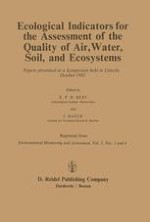1983 | OriginalPaper | Chapter
Bioindication of a Surplus of Heavy Metals in Terrestrial Ecosystems
Authors : W. H. O. Ernst, J. A. C. Verkleij, R. Vooijs
Published in: Ecological Indicators for the Assessment of the Quality of Air, Water, Soil, and Ecosystems
Publisher: Springer Netherlands
Included in: Professional Book Archive
Activate our intelligent search to find suitable subject content or patents.
Select sections of text to find matching patents with Artificial Intelligence. powered by
Select sections of text to find additional relevant content using AI-assisted search. powered by
A survey of the methods of bioindication of heavy metals in terrestrial ecosystems and their effectiveness for predicting the consequences of environmental stress on organisms is presented. Two main inputs of heavy metals for terrestrial ecosystems have been considered: airborne and soil-borne.Airborne metals can be monitored due to physical adsorption on plant surfaces or due to chemical exchange processes in cell walls. Active biomonitoring widely uses both aspects, however, without predictive values.Meaningful bioindication of soilborne heavy metals can only be achieved by passive monitoring. Due to the different functions of heavy metals in organisms - micronutrients and trace elements - the knowledge of natural background values is important, considering the qualitative aspects of metals in the soil. In exceptional situations morphological and anatomical changes of plant organs will facilitate bioindication; in every case chemical analysis of the concentration of heavy metals is an essential part of the monitoring program.A long-term exposure of organisms to heavy metals will influence the genetic structure of populations. Therefore measurement of heavy metal tolerance of plants has to be a standard procedure in monitoring programs.
